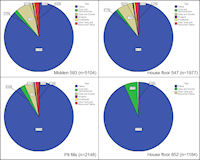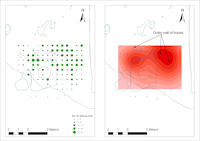
Figure 12: The composition of the worked flint assemblages from pits, house floor 547, house floor 852 and midden 593
In general, the composition of the assemblages from the different types of contexts at the East Entrance (e.g., pits, middens and house floor 547) are extremely similar to one another (Fig. 12). This tends to suggest that they represent deposition from similar sets of activities. These practices involved the entire chaîne opératoire, from primary core trimming to the utilisation of tools. Hence, while flint tools were produced rapidly to meet immediate needs, the lack of variation across the assemblage suggests that either a restricted range of activities took place in the immediate environs of the East Entrance or that a wide range of activities were conducted using a restricted range of tools.

Figure 12: The composition of the worked flint assemblages from pits, house floor 547, house floor 852 and midden 593
The most significant variation in assemblage composition is between the material from the floors of Houses 547 and 851 (Figs 12 and 13) (nb the floor of House 851 is house floor context 852, the floor of House 547 is house floor context 547). The distribution of material from House 547 indicates a varying density (Fig. 14); while most of the house floor was relatively clean, there was a distinct concentration between the hearth and the doorway. This concentration contained a number of large artefacts including cores, material that would have been uncomfortable underfoot and unlikely to have been routinely left in the area of the main entrance to the house. Importantly, the largest concentration of material occurs around the north-east side of the structure, outside of it, where it appears to respect the line of stake-holes that represent the house's outer wall. This strongly suggests that the material was deposited while the structure was still standing, with several concentrations of worked flint inside the structure and another concentration piled up against the outside of the house.

Figure 14: The density of worked flint from house floor 547 expressed as point density (left) and kernel density (right) distributions
Although the assemblage from House 547 is similar in composition to the surrounding midden, the same cannot be said for material from house floor 852 (Fig. 12). During excavation this house floor appeared visibly 'cleaner' than other house floors (Fig. 15), which may have been partially because of the lack of larger components. In particular, unlike all other contexts examined from the site, this house floor contained no cores, and tools were heavily under-represented, with only six retouched flakes, a single burnt and broken knife and a single arrowhead being found.
The differences between these two house floors are clear. The absence of cores and tools from the floor of House 851 need not necessarily mean that knapping or tool use did not take place there. Instead, it is likely that House 851 was kept relatively clean. This basic maintenance is perhaps what we might associate with a house that was still in use until the end of occupation on this part of the site. In this respect, it should be noted that the cleanest area of the floor is that between the hearth and where the door is thought to have been in the south-west corner of the house (Fig. 15). The areas that contain the densest concentrations of worked flint are those around the edges of the house, where beam slots suggest that some sort of furniture once stood. The presence of these interior structures may have either hindered the sweeping out of waste from the floor or made it unnecessary. In either case, the possibility of active floor cleaning highlights the problems of identifying the activities that took place within such structures.
The floor of House 547 was more strewn with material. It is thought that this debris represents a post-abandonment phase of use of the house. Several of the houses evidenced complex processes that took place at the end of their use. Some of these activities involved the digging of 'closing' pits associated with specific depositional acts; other acts appear to have been conducted in a more casual fashion. Perhaps the structures were used on an ad hoc basis as working shelters until they collapsed or were removed. At present the nature of these final acts is still under investigation, but hopefully the analysis of further house floor assemblages will permit a more detailed assessment of the significance of these house closing episodes.
© Internet Archaeology/Author(s) URL: http://intarch.ac.uk/journal/issue26/2/6.html
Last updated: Wed May 27 2009